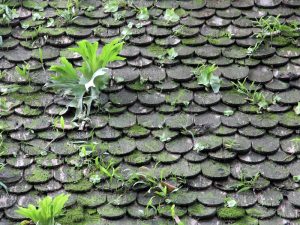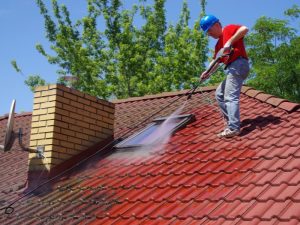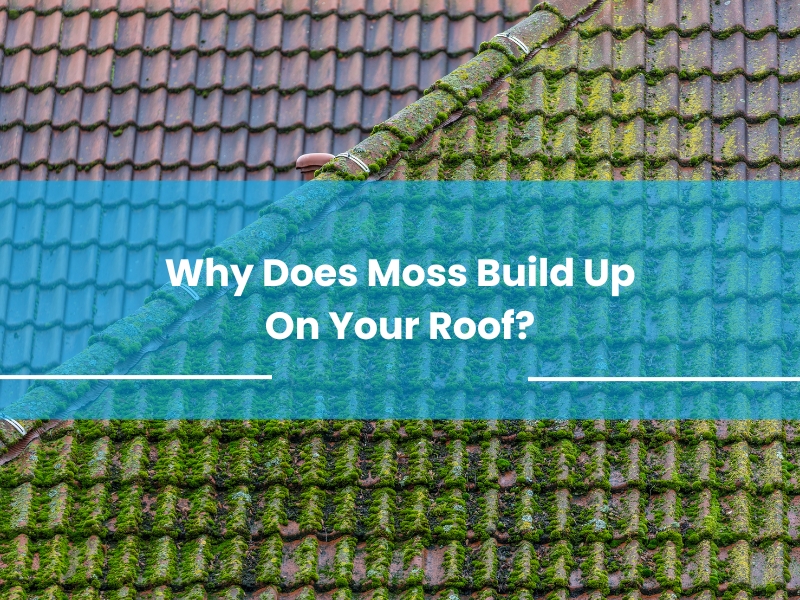Moss can flourish on a roof with abundant moisture, creating a verdant carpet. While it might seem harmless, it can lead to various problems. This article explores why moss grows on roofs and the potential consequences. We will also discuss effective prevention and removal methods.
What causes moss to grow on your roof?
Moss thrives in specific conditions, and several factors contribute to its growth on roofs. Here’s what you should know:
- Moisture: Moss loves damp environments. If your roof retains moisture, moss will likely build up. This can happen in areas with high humidity or frequent rainfall.
- Shade: Roofs shaded by trees or other structures are more prone to moss growth. The lack of sunlight prevents moisture from evaporating.
- Roof Material: Certain materials, such as wood or asphalt shingles, can retain moisture better than others, making them more susceptible to moss growth.
- Poor Ventilation: Inadequate airflow can accumulate moisture in your roof’s structure, creating an ideal environment for moss to flourish.
- Debris Accumulation: Leaves, twigs, and other debris can trap moisture and provide nutrients for moss. Regular cleaning can help prevent this.
Is moss on your roof terrible for your home?
Understanding the moss lifecycle is crucial for effective prevention and removal. While moss may seem harmless, it can pose several risks to your home. Here are some potential issues:
- Water Damage: Moss can lead to roof leaks. Over time, this can compromise your roof’s integrity.
- Structural Issues: Prolonged exposure to moisture can weaken roofing materials, leading to sagging or even structural failure in severe cases.
- Aesthetic Concerns: Moss can make your home look unkempt, which may affect its property value and curb appeal.
- Pest Attraction: Moss can attract pests such as insects or rodents, which may lead to further complications in your home.
- Health Risks: Accumulated moss can contribute to mould growth, posing health risks for you and your family.
How does roof design contribute to moss growth?
The design of your roof can significantly influence moss development. Here’s how:
- Pitch and Slope: Flat or low-slope roofs tend to retain water, creating a breeding ground. Steeper roofs allow for better drainage.
- Overhangs: Roof overhangs that extend too far can create shaded areas where moss can thrive.
- Complex Roof Lines: Roofs with multiple valleys, dormers, or other complex features may trap debris and moisture.
- Material Choices: Some roofing materials, such as metal or tiles, are less susceptible to moss growth than asphalt or wood shingles.
- Gutters and Drainage: Poorly maintained gutters can lead to water overflow.
Can moss damage your roof over time?
If left untreated, moss can indeed cause substantial damage to your roof. Here are some potential consequences:
- Shingle Lift: Moss can cause shingles to lift, creating gaps where water can seep through, leading to leaks and water damage.
- Granule Loss: As it grows, it can dislodge the granules on asphalt shingles, reducing their effectiveness and lifespan.

- Underlying Rot: The moisture retained by moss can lead to rotting in the underlying wooden structure, which may require costly repairs.
- Decreased Lifespan: Moss damage can significantly reduce the overall lifespan of your roof.
What are the best ways to prevent moss build-up?
Preventing moss from taking hold is crucial for maintaining your roof. Here are some effective strategies:
- Regular Cleaning: Remove leaves, twigs, and other debris from your roof and gutters regularly to prevent moisture retention.
- Trim Trees: Keep trees trimmed back to allow sunlight to reach your roof and reduce shaded areas.
- Improve Ventilation: Maintain proper ventilation in your attic to prevent moisture buildup and ensure optimal airflow.
- Install Zinc or Copper Strips: Installing metal strips at the ridge of your roof can help prevent moss growth. Rainwater will wash down the metal, inhibiting moss development.
- Choose Suitable Roofing Material: If you’re replacing your roof, consider metal or tile, which are less prone to moss growth.
How can you safely remove moss from your roof?
If you already have moss on your roof, it’s essential to remove it safely. Here are some methods:
- Soft Bristle Brush: Gently scrub the moss with a soft bristle brush to avoid damaging your shingles.
- Moss Removal Solutions: Use removal products specifically designed for roofs. Always follow the manufacturer’s instructions.
- Water and Bleach Solution: A diluted water and bleach solution can effectively kill moss. Be cautious, as bleach can harm surrounding vegetation.
- Pressure Washing: While effective, pressure washing can also damage your roof if not done correctly. Use a low-pressure setting and avoid directly blasting shingles.
- Hire Professionals: If you need clarification or are uncomfortable with the process, consider hiring professionals for safe and effective removal.
Should you hire a professional to deal with roof moss?
Hiring a professional can be beneficial in several ways. Here are some reasons to consider:
- Expertise: Professionals have the experience and knowledge to eliminate roof moss and implement preventive measures to avoid future growth.
- Safety: Working on a roof can be dangerous. Professionals are trained to work safely and have the necessary equipment.

- Long-term Solutions: Experts can provide ongoing maintenance and advice to help prevent moss growth in the future.
- Quality Assurance: Hiring a professional ensures the job is done right, protecting your investment in your home.
- Comprehensive Services: Many roofing companies offer additional services like roof inspections, cleaning, and repairs.
Take action now: Prevent moss damage
Moss build-up on your roof can lead to severe issues if not addressed. By understanding the causes and effects of moss growth, you can take proactive steps to maintain your roof’s health. Whether you need a cleaning or a full inspection, our team is here to help. Our team of professionals is equipped to handle all your roofing needs. Contact High Class Roofing today to schedule a consultation and keep your roof in top condition!


